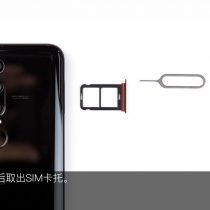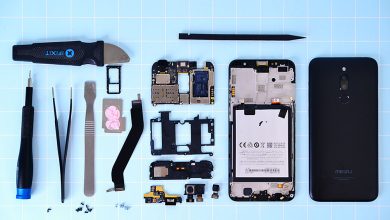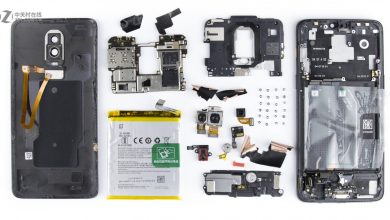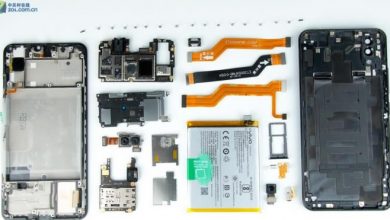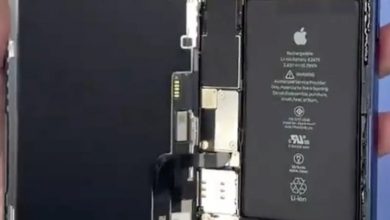The Huawei Mate RS went on sale on April 14, 2018. With outstanding appearance and excellent performance, this phone has attracted attention from the public. Today, we will start the teardown of the Huawei RS to explore its internal design and workmanship.
First of all, remove the SIM card tray. Heat up the back cover for five minutes before taking it out. The top and bottom of the back cover are fixed by glues, so we need to be careful when removing the back cover.
The back can’t be completely separated from the phone body since the fingerprint cable is still connected to the motherboard. White super glue tightly fixes the back cover to the phone body, and in the meantime, this glue guarantees the back cover has good sealing performance.
From the fingerprint scanning chip, we know that this scanner is made by one of the top-level biometric manufacturers, Goodix, in China. It is said that this manufacturer also provides the front under-display optical fingerprint reader.
There is no other electrical component integrated into the back cover except the fingerprint reader module. The motherboard is covered by heat dissipation material to avoid heat congregation. A layer of foam has been placed in the gap between the battery and the back cover.
After uncovering the wireless coil, the battery still can’t be seen since a graphite sticker is placed between the coil and the battery. Such a design is to avoid high temperatures in some areas since the coil and battery will generate heat during the wireless charging process.
Before removing the plate on the top, we need to remove the LDAF module from the camera, or the cable will be disconnected. We also need to remove the LED detective module.
The right part of the plate is covered by thermal grease, which is used to help the chip’s heat dissipation. Connectors are designed with foam mats to prevent connectors from poor contact.
Next, disconnect the connectors of the vice board cable, button cable, display cable, and touchscreen cable on the bottom of the motherboard.
It is reported that all three Huawei P20 Pro cameras support the OIS function. After testing the phone’s three cameras, we found that only the telephoto camera adopts OIS technology while the other two cameras don’t adopt it.
Although the front camera is smaller than the main camera, it is not small compared with other front cameras. As we all know, this smartphone features a 24MP front camera with an F/2.0 aperture.
These are some chips that this smartphone uses. Most of these chips the Huawei RS uses are the components that the P20 Pro adopts. The phone’s motherboard is smaller than the P20 Pro’. In addition, bare circuits on the motherboard have been well protected.
There are three main chips integrated into the back of the motherboard, including the RAM, processor, and ROM. The memory chip and AI Kirin 970 processor are sealed together. The battery charging management adopts the currently popular TI BQ25892 chip.
The power management chip and a lot of filter capacitors are placed on the side of the motherboard.
The back of the motherboard
Broadcom BCM43596XKUBG Wi-Fi, BlueTooth Chip
Skyworks 78113-14 LTE RF Chip
Skyworks 78114-61 LTE RF Chip
Skyworks 78117-4A LTE RF Chip
Hisilicon Hi6363 RF Transceiver
The front of the motherboard
TI BQ25892 Power Management Chip
Micron 8CD74 D9VNW 6GB RAM + Hisilicon 970
Samsung KLUEG8U1EA-B0C1 256GB UFS2.1 TLC ROM
We found that the design of this phone is better than the iPhone X. Chips that generate a lot of heat are placed on the outer layer of the motherboard. This way, thermal materials can be utilized to help these chips get better cooling performance. The iPhone X even puts the processor on the inner layer of the motherboard.
Then, remove all the screws which are used to fix modules at the bottom of the phone body. The vice board is also highly utilized to save space at the bottom of the phone. Two microphones have been integrated into the vice board. Metal contacts at the bottom are connected to a vibrator, loudspeaker, and antenna. Take out the loudspeaker module. The foam around the module is to prevent water from entering inside.
Red rubber is placed around the port of the loudspeaker. The dustproof net uses a material with a glossy surface and small, dense mesh. It is inferred that this material is similar to what the Samsung S8 has adopted. This material can keep vapor outside and allow air circulation without affecting sound quality.
The loudspeaker is made by AAC Technologies Holdings Inc. It has excellent low-frequency performance.
To make the next teardown easier, we heat up the screen first. Then, we use a thin plastic tool to remove the battery. The battery gets deformed. Much glue has been applied at the bottom of the battery. Besides, the display cable is under the battery. Be careful not to disconnect the display cable.
Now, the battery has been successfully removed. It has a capacity of 4000mAh and supports 25W low-voltage fast charge technology. Even though this battery has a large capacity, it can be fully charged within two hours.
It takes us a longer time to tear down this phone than other Android smartphones. This phone has a complex design on the upper part. After this teardown, we saw an all-new internal design. This phone also has excellent heat dissipation performance and good sound.
According to the display cable, we know that the screen feature of this phone is provided by LG.
In general, the Huawei Mate RS is one of the smartphones in China with a superior internal design. Although its price may scare away many people, this phone’s workmanship has undoubtedly reached the top level in China.


